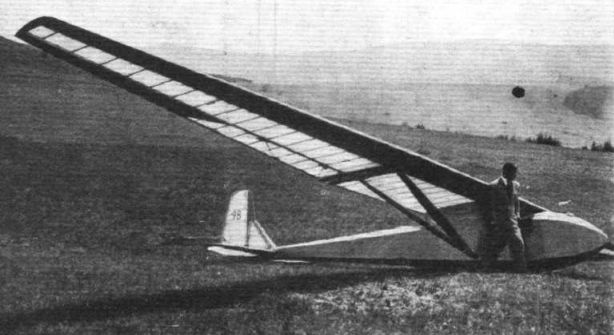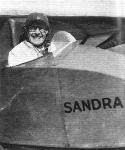
Варианты
- Lippisch / RRG - Professor - 1928 - Германия
- Lippisch / RRG - Wien - 1929 - Германия
M.Simons The World's Vintage Sailplanes 1908-45
THE PROFESSOR
In 1926 Max Kegel, flying a robust sailplane of his own design but following the lines of the Darmstadt school, was seized by powerful air currents and whisked upward into a big cloud. He lost control and was lucky to emerge from the cloud after a few minutes. The theory that upcurrents associated with clouds could lift a sailplane was now proved. At Darmstadt, early in 1928, experiments with a light aeroplane were conducted. Nehring, directed by Dr Walther Georgii, flew toward likely looking clouds and discovered that with the motor throttled back or even stopped, he could maintain height. Georgii and Lippisch discovered that balloonists used sensitive rate of climb indicators and adapted one of these instruments for gliders. To try it came Robert Kronfeld, a young Viennese who had taken up gliding. At the Rhoen meeting in 1928, Kronfeld kept the instrument with him in a small box. None of the pilots knew what it was for.
The sailplane Kronfeld was to fly was also new. It was intended to follow on from the Pruefling trainer, not a superperformance aircraft, but one that could be built by clubs and flown by pilots of moderate experience. It was designed by Lippisch and the first one was built in the RRG workshops on the Wasserkuppe. As a follow-on type from the Pruefling (Examinee) it was called the Professor type. The prototype, flown by Kronfeld, was given a personal name in honor of Oskar Ursinus, who was known as Rhoengeist (Spirit of the Rhoen).
The fuselage was a six-sided box structure of light timber covered with plywood. There were no complicated curved members. The wing was in three sections, a rectangular centre section with detachable, strongly tapered tip panels which carried the ailerons. ‘V’ struts braced the wing to the fuselage. The tailplane and rudder were of the all-moving type. The wing was mounted well above the fuselage on a narrow pylon, ensuring a clean flow over the upper surface. The cockpit remained open, without even a windscreen.
Early flight trials satisfied Lippisch that the aircraft was good enough for its purpose, though there were some deficiencies in control, particularly with the ailerons. Another defect of the Professor was that its tapered wing tended to encourage tip stalling and it was easy to fall into a spin from a slow turn.
Still, Kronfeld showed that the Professor was capable of excellent soaring. On what was to become an historic day, he took off with nothing very much more in mind than the idea of trying to win a daily prize for the longest duration flight from the Wasserkuppe. Once airborne and established in the slope lift along with several other contestants, he decided to use the variometer to investigate the effect of the cumulus clouds that drifted overhead. Sure enough, as a cloud came over, the variometer showed a good rate of climb. Then when the cloud had moved further downwind, the Professor would sink back into the slope lift effect. After several trials, when the next cloud produced its extra lift as expected, he flew round in circles watching the variometer. Climbing slowly, he drifted downwind of the launching site. The Himmelsdunkberg, a rather inconspicuous mountain, one of the general Rhoen group, had some temporary significance in gliding history because at the previous Rhoen contest. Nehring had performed a fine out-and-retum soaring flight using it as a turning point. He had done this by slope soaring. Kronfeld realised he might now be able to equal Nehring’s achievement. Instead of circling longer under his drifting cloud, he left it, tracked diagonally to the wind, and soon was slope soaring again over the Himmelsdunkberg. He waited there until another cumulus cloud came along and as before found it lifting him higher. To his delight, after the first cloud there was another and then another, a regular aerial highway or street of clouds, each of which sustained him as he flew straight ahead. He arrived back over the launching point at an altitude of more than 500 metres.
From this day on, soaring by circling under cumulus clouds became a regular thing. Kronfeld took part in an adventurous expedition with the Rhoengeist and a Pruefling, to the Austrian Alps. The month-long trip, financed by a Viennese illustrated paper, took place in midwinter. The Professor was carried up the mountains in pieces, suspended on cable cars, with the wings and fuselage tied on the outside of the car whilst the pilot and crew rode within. Launches, from deep snow at altitudes only a little less than 2000 metres above sea level, were very difficult. Despite this, some excellent flights were made and a good deal was learned about mountain soaring.
Meanwhile, blueprints for the Professor were offered for sale. Many clubs began construction of their own sailplanes and the Segelflugzeugbau Kassel established a small production line. When Kronfeld and Magersuppe toured England in 1930, the latter took a Professor with him and demonstrated it although he had the misfortune to land in the sea after attempting to soar from the cliff near Scarborough. In America, Gus Haller and Martin Schempp built several Professors, re-naming the type the Haller Hawk. These became well known at soaring meetings in the USA. In England the London Gliding Club bought a Professor and it remained the best club sailplane for some years.
Technical data:
Professor: Span, 16.10 m. Wing area, 18.6 sq rtf. Aspect ratio 14. Aerofoil, Goettingen 549. Flying weight 246 kg. Wing loading 14.7 kg/sq m.
- M.Simons The World's Vintage Sailplanes 1908-45
Фотографии
-
Flight 1929-12 / Flight
A photograph showing Herr Kronfeld and the glider in which he flew 100 km. over the hills by the Teutsburger Forest
-
GL / M.Simons - The World's Vintage Sailplanes 1908-45 /Kookaburra/
A Hungarian version of the Professor, built in 1933 from German plans, with some improvements such as a cockpit fairing on the nose and room for an instrument panel. In other respects the aircraft appears to have been almost a standard Professor.
-
GL / M.Simons - The World's Vintage Sailplanes 1908-45 /Kookaburra/
The London Gliding Club's Professor at Dunstable. The other sailplane was Manuel’s Crested Wren.
Другие самолёты на фотографии: Manuel Wren - Великобритания - 1931
-
Flight 1932-06 / Flight
Flt. Lt. J. Armour pilots a "Professor" at the London Gliding Club's ground on Dunstable Downs at Totternhoe.
-
Flight 1931-06 / Flight
Mr. Lissant Beardmore with his Proffessor Sailplane, on which he crossed the Channel the day before Herr Kronfeld did the return trip.
-
GL / M.Simons - The World's Vintage Sailplanes 1908-45 /Kookaburra/
Martin Schempp in a Haller Hawk in the USA.
-
GL / M.Simons - The World's Vintage Sailplanes 1908-45 /Kookaburra/
Nehring about to take off from the Wasserkuppe summit in the Darmstadt 2 during the 1928 Rhoen contest. Note the external instrument housings. In the background of this picture is Kronfeld's Rhoengeist, the prototype Professor.
Другие самолёты на фотографии: Darmstadt D-17 / D-19 Darmstadt / D-20 Starkenburg - Германия - 1927
-
Aeroplane Monthly 1991-09 / M.Challinor - 60 years of Ups on the Downs
Ivinghoe Beacon, with Capt. Needham gliding in a "Professor."
-
GL / M.Simons - The World's Vintage Sailplanes 1908-45 /Kookaburra/
A Professor, flown by R. Hakenjos, over the Wasserkuppe in 1931. The contest number 25 on the rudder would have been only temporary. The dark patch above it may have been where the previous season’s number was painted over. On the fuselage were two dark vertical bars followed by the letter D for Deutschland.
-
Flight 1937-09 / Flight
SILENT SERENITY: A pleasant impression of a Professor sailplane over the Midland Gliding Club's site at Long Mynd, Shropshire.
- Фотографии











